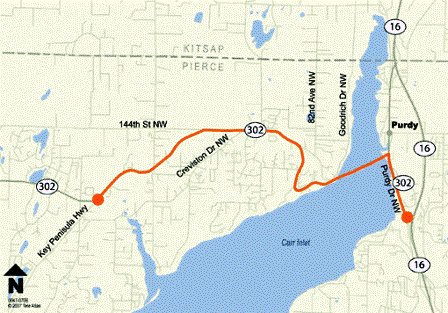Chris Fitzgerald, KP News
The Washington State Department of Transportation (WSDOT) began the first phase of its $5 million environmental study of State Route 302 in July, just in time for Vicki Steigner, assistant planning manager for WSDOT Olympic Region, to host a booth at the Key Peninsula Community Fair. Her staff gathered replies to short surveys, asked fair-goers to circle their primary focus of concern on SR-302 maps, write comments in the margins, and talk about their frustrations with the existing highway. The results of that interaction (which can be found at www.wsdot.wa.gov/projects/sr302/newcorridor) supply no surprises, or anything astonishing that wasn’t already obvious when WSDOT spent millions on a previous study in 1993. The section of SR-302 that is part of the study. Graphic courtesy WSDOT
The section of SR-302 that is part of the study. Graphic courtesy WSDOT
Citizens complaints range from the opposite poles of “traffic too slow” to “traffic too fast” and include commentary about the inadequacy of the bridge at Purdy Spit; calls for the use of Pine and/or Powerline roads as new arterials; and requests for lighting along dark alternate routes, signage, passing lanes, and more enforcement of speed limits. Why the state could not use the $5 million to begin correcting some of these deficiencies can be explained away with the statement that the 1993 Environmental Impact Study (EIS) expired (current state guidelines provide for a maximum three-year EIS lifespan) and recommendations made then may no longer be viable now.
This new study, which includes no action of any kind during its implementation, is expected to take three to five years to complete. The current growth rate on the KP is not expected to wane, and the project’s end-result EIS will still expire in three years unless state guidelines change, potentially resulting in yet another fruitless expenditure of gas-tax revenues. During the two-year comprehensive planning sessions recently concluded, citizens consistently pleaded for small and economically practical immediate fixes such as safety “turtles” on centerline dividers, signage, and reflectors, none of which appear to be on the near horizon.
WSDOT’s Website says, “State Route 302 has a six-mile long high accident corridor. The main reason for this project is to improve safety on the route… The study will evaluate the environmental impacts of creating a new corridor or widening the existing State Route 302 to improve mobility and enhance motorist safety.” No mention is made of tangible action. What the department will do is “spend eight months collecting data, evaluating existing conditions and determining motorist travel patterns.” The second phase of the study is expected to begin next January.
Steigner plans to host a public event in mid-September at Peninsula High School, and asks the public’s help in “identifying the problems and what they see as concerns.” She envisions a drive-time meeting that will capture commuters on their way home and plans to display maps and have break-out tables arranged by topic or concern, along with a short presentation. Her primary concern, she says, is to begin designing a tiered set of alternatives, with safety being the first, to make SR-302 less dangerous.
Steigner said her crew will be out counting cars at intersections: how many turn left, how many turn right, and when. They will chart the traffic before and after school, during drive-time and at midday, and will look at the most treacherous intersections where drivers “take risks they shouldn’t take” to discover specific ways the intersections work — or don’t. She welcomes citizen calls. When WSDOT crews are out near the road with a clipboard, waiting in a truck behind an electronic counting signboard, or walking the roads looking for clues, she encourages those who know the road to stop and take a minute to give them some answers.
UNDERWRITTEN BY THE FUND FOR NONPROFIT NEWS (NEWSMATCH) AT THE MIAMI FOUNDATION, THE ANGEL GUILD, ADVERTISERS, DONORS AND PEOPLE WHO SUPPORT INDEPENDENT, NONPROFIT LOCAL NEWS